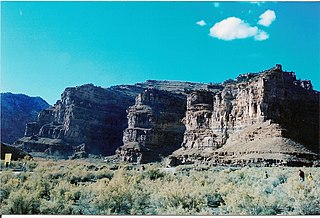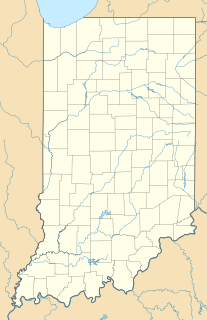
Kanab Creek is one of the many tributaries of the Grand Canyon. It begins in Kane County, Utah, just south of the watershed to the Great Basin and flows 125 miles (201 km) south to the Colorado River. It passes Kanab, Utah, crossing the border to Arizona near Fredonia. It flows through the Kaibab Indian Reservation of the Paiute people and the 1984-designated Kanab Creek Wilderness, a wilderness area, before its mouth in the Grand Canyon National Park.

Nine Mile Canyon is a canyon, approximately 40 miles (60 km) long, located in the counties of Carbon and Duchesne in eastern Utah, in the Western United States. Promoted as "the world’s longest art gallery", the canyon is known for its extensive rock art, most of it created by the Fremont culture and the Ute people. The rock art, shelters, and granaries left behind by the Fremont make Nine Mile Canyon a destination for archaeologists and tourists alike.
Johnson Siding is an unincorporated community in Pennington County, South Dakota, United States. The population as of the 2010 census was 659. It is located in the Rimrock Area, about 10 miles west of Rapid City. It is surrounded by the Black Hills National Forest. It is the only significant business district in the Rimrock Area, with a gas station/general store, deli, casino, tavern, the Johnson Siding Volunteer Fire Department firehouse, the Rimrock Evangelical Free Church meetinghouse, and a community center. However, most inhabitants work in Rapid City or Deadwood.

Folsomville is an unincorporated community in Owen Township, Warrick County, in the U.S. state of Indiana.

Collinston is an unincorporated community on the northeastern edge of Box Elder County, Utah, United States.

Ridgeview Village is an unincorporated community in El Dorado County, California. It lies at an elevation of 1066 feet.

Quitchupah Creek is a stream draining portions of Emery and Sevier Counties in central Utah, in the western United States. Quitchupah Creek is significant for its rock art remains of the Fremont culture that line its banks. Quitchupah is Ute for "animals fare poorly." The drainage area is located within the Colorado River Basin near the south end of the Wasatch Plateau. All drainage from the area flows to Quitchupah Creek or its tributaries, including East Spring Canyon, Water Hollow, and North Fork and flows through Convulsion Canyon.
Mollie's Nipple or Molly's Nipple is the name given to as many as seven peaks, at least one butte, at least one well, and some other geological features in Utah. Some sources claim there are eleven geological features in Utah that bear this name. At least some of those names are attributed to John Kitchen – a pioneer of an early exploration of Utah, who named them to commemorate a nipple of his wife Molly.
Crystal Canyon is a canyon on the northeastern edge of Juab County, Utah, United States.
Dead Ox Canyon is a canyon in southern Morgan County, Utah, United States.
Mountain Meadow or Mountain Meadows, is an area in present-day Washington County, Utah. It was a place of rest and grazing used by pack trains and drovers, on the Old Spanish Trail and later Mormons, Forty-niners, mail riders, migrants and teamsters on the Mormon Road on their way overland between Utah and California.
Cove Creek is a stream in Beaver County and Millard County, Utah. It originates at the head of its canyon southeast of Cove Fort at 38°38′09″N112°29′34″W in Beaver County. It drains north down through the Tushar Mountains then turns west at the foot of Sulphur Peak running between the south end of the Pavant Range and the Tushar Mountains, past Cove Fort, from which it received its name. It then runs west past the north end of the Mineral Mountains to disappear into the sands of the desert at Beaver Bottoms.
Holt Canyon, originally called Meadow Canyon or Meadow Valley, is a valley in Washington County, Utah. Its mouth lies at an elevation of 5,387 feet / 1,642 meaters where it enters the Escalante Valley. Its head lies at an elevation of 5,600 feet at 37°32′32″N113°36′46″W west of the site of the ghost town of Hamblin, Utah.
Fremont Wash sometimes called Fremont Canyon in its upper reach, is a stream and a valley in the north end of Parowan Valley, in Iron County, Utah. Its mouth lies at its confluence with Little Salt Lake at an elevation of 5,686 feet / 1,733 meters. Its head is found at 38°07′46″N112°34′36″W, the mouth of Fremont Canyon, an elevation of 6,476 feet / 1,974 meters.
Doubleup Hollow is a valley in the Black Mountains in Beaver and Iron County, Utah. Its mouth lies at an elevation of 6,450 feet / 1,966 meters. It heads at 38°07′34″N112°44′14″W, at an elevation of 7,680 feet, in Beaver County.
Nevershine Hollow is a valley east of the South Hills, in Beaver County, Utah. The mouth of the valley is at the elevation of 6,165 feet / 1,879 meters. Its head is at an elevation of 6,500 feet at 38°09′43″N112°36′38″W, north of Beaver Ridge.
Beaver Ridge a ridge in Beaver County, Utah. It lies south of Nevershine Hollow and north of the canyon of Fremont Wash. It reaches an elevation of 6,552 feet / 1,997 meters.
California Hollow is a valley in the Black Mountains in Beaver and Iron County, Utah. Its mouth lies at an elevation of 6,414 feet / 1,955 meters. It heads at 38°08′41″N112°42′48″W, at an elevation of 6,940 feet, in Beaver County.

Parowan Valley, originally known as the Little Salt Lake Valley, is a basin in Iron County, Utah, United States.
Coal Creek is a stream in Iron County, Utah. Its mouth lay at an elevation of 5,545 feet (1,690 m) in Cedar Valley in 1979, but that location is now a farm field, and its new terminus is located a little further upstream, 4.3 miles (6.9 km) northwest of Cedar City, Utah. Its source is at the confluence of Crow Creek and Ashdown Lake Creek, in Coal Canyon, at the foot of Cedar Mountain at 37°37′49″N112°56′10″W at an elevation of 7,075 feet (2,156 m). Coal Creek passes through Cedar City on its way to Cedar Valley.










